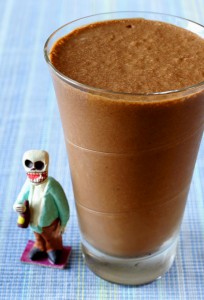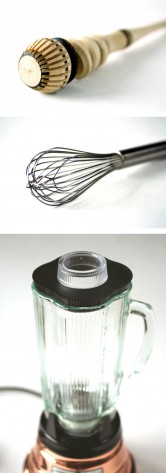Frothed Mexican Drinking Chocolate

On the Day of the Dead, or any day, I like Mexican drinking chocolate served chilled and “on tap,” with a head. Thus began frothing sessions with a molinillo, a whisk, and, because I have a case of “lazy arm,” a blender, the latter being  completely nontraditional and inauthentic. All work, to slightly different effect, and can be seen in action in the video “Frothing Drinking Chocolate,” below.
completely nontraditional and inauthentic. All work, to slightly different effect, and can be seen in action in the video “Frothing Drinking Chocolate,” below.
Before the frothing experiments could begin, however, I needed to develop a recipe for drinking chocolate using Mexican chocolate.
Having a variety of leftover dried chiles as well as some ideas for ingredient pairings from the days of cooking from The Art of Mexican Cooking, a DCCC cookbook pick earlier this year, the peripheral flavors were not in question. But what chocolate to use?
After sampling a few different brands, I settled on Taza chocolate, a good quality Mexican-style chocolate with excellent flavor that is both organic and fair trade, and traditionally processed using granite mill stones in Boston. Wanting a plain chocolate that I could add my own Mexican flavors to, I opted for their unflavored “cacao puro” in the traditional disc shape. It is made of only two ingredients: single origin Dominican cacao and sustainably grown, raw cane sugar.
Before arriving at the recipe that follows, I tried several different versions—one with the chile guajillo, the chile mulato, and the chile ancho; one with sesame seeds and one with pumpkin seeds; one with and without salt; and one made solely with water.
Mayans and Aztecs would have made their drinking chocolate with water and often unsweetened. (If sweetened, it would have been sweetened with honey; cows and sugar were introduced by the Spanish.) I made the first batches with water, but found the drink a bit thin and acidic. In the end I decided milk is a good addition, as it mellows the naturally acidic notes found in Mexican-style chocolate.
 Aztecs viewed chocolate as a fortifying drink; in this vein, I like to think the addition of sesame seeds gives the drink extra body and nutrients. However, if you don’t have any sesame seeds on hand, simply omit them; though they do add a subtle flavor to the drink, it is quite good without them.
Aztecs viewed chocolate as a fortifying drink; in this vein, I like to think the addition of sesame seeds gives the drink extra body and nutrients. However, if you don’t have any sesame seeds on hand, simply omit them; though they do add a subtle flavor to the drink, it is quite good without them.
If my recipe is too involved for you—it does require toasting spices, resuscitating a chile, and pureeing the lot in a blender—consider trying some of Taza’s many excellent flavored Mexican-style chocolates. You then only need to dissolve the chocolate in hot milk and drink it hot or cold, as you wish, keeping the ratio of chocolate to liquid the same (1 disc chocolate: 1 cup milk). (To see the full range of Taza’s flavored chocolates, as well as instructions for and a video of the traditional frothing method, using hot water, visit Taza’s website.)
Makes about four 8-ounce servings
One piece cinnamon (2½ to 3 inches long), broken into thin strips
4 cloves
4 teaspoons sesame seeds (optional)
1 chile mulato, about 5 to 6 inches long, not including the stem (see Note)
¾ cup water
3¼ cups whole milk
4 discs (two 2.7-ounce packets) Taza Mexican-style chocolate (70% “cacao puro”), finely chopped
Pinch of sea salt
1½ tablespoons sugar or honey, or to taste
- Heat a small skillet over medium heat. When hot, toast the cinnamon and cloves, until fragrant, stirring the spices or shaking the pan constantly, about 20 seconds. Remove from the pan.
- To the same skillet, add the sesame seeds, if using, and toast over medium heat, stirring the seeds or shaking the pan constantly, until light golden brown and aromatic, about 10 to 15 seconds. (Be careful: Once the seeds start to release their oil and become aromatic, they can burn very quickly.)
- Toast the chile in the same skillet over medium heat for about 30 seconds on each side, pressing the chile down with a spatula, until it begins to turn a brick red color and becomes aromatic. Place in a bowl, cover with hot water, and place a small bowl or plate on top to keep the chile submerged. Let soak for 20 to 25 minutes, until soft and pliable.
- Remove the stem and, if you want primarily the flavor of the chile with little or none of its heat, the seeds and membranes. It is easiest to remove the seeds and membranes under running water. (I prefer to remove the seeds and membranes to not overpower the nuanced flavor of Taza chocolate with too much chili heat.)
- Place the toasted spices and resuscitated chile in a blender jar with ½ cup of the water. Puree until smooth, scraping down the sides of the jar two or three times.
- Heat the milk in a heavy bottomed saucepan over medium heat, stirring frequently. When the milk is just coming to a simmer, add the chocolate, reduce the heat to medium-low, and, stirring constantly, heat until the chocolate is melted and all the small bits of chocolate are incorporated.
- Strain the puree through a fine-mesh strainer into the hot chocolate. Add the remaining ¼ cup of water to the blender jar and process briefly; pour into the strainer. Push the pulp against the strainer to extract as much liquid as possible. Add the salt and sugar to the chocolate and stir to combine. Let the flavors meld, stirring frequently, over medium-low heat, for 5 minutes. If the chocolate begins to simmer, lower the heat.
- Serve hot or cold; if serving cold, let cool to room temperature before chilling in the refrigerator. The chocolate is even better the next day, and will keep for several days in the refrigerator.
- Before serving, froth the chocolate using a molinillo, whisk, or a blender (see video below).
Note: The chile mulato is blackish-brown in color and ranges greatly in size, but on average is about 5 inches long. Reminiscent of dried prunes, the flavor is on the sweet side and complements chocolate. It varies in heat level from mild to rather hot, making for an exciting variable in the kitchen.
